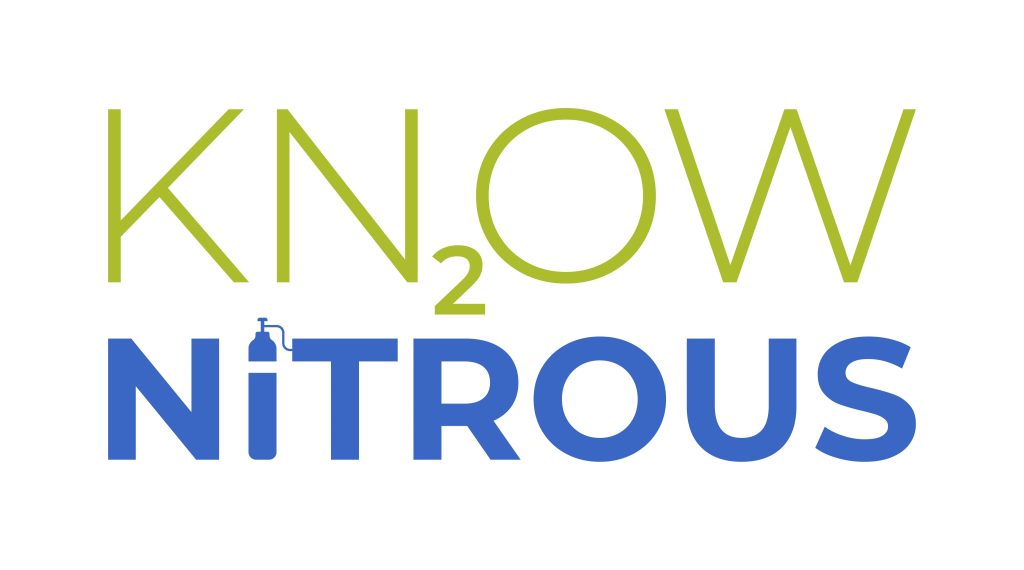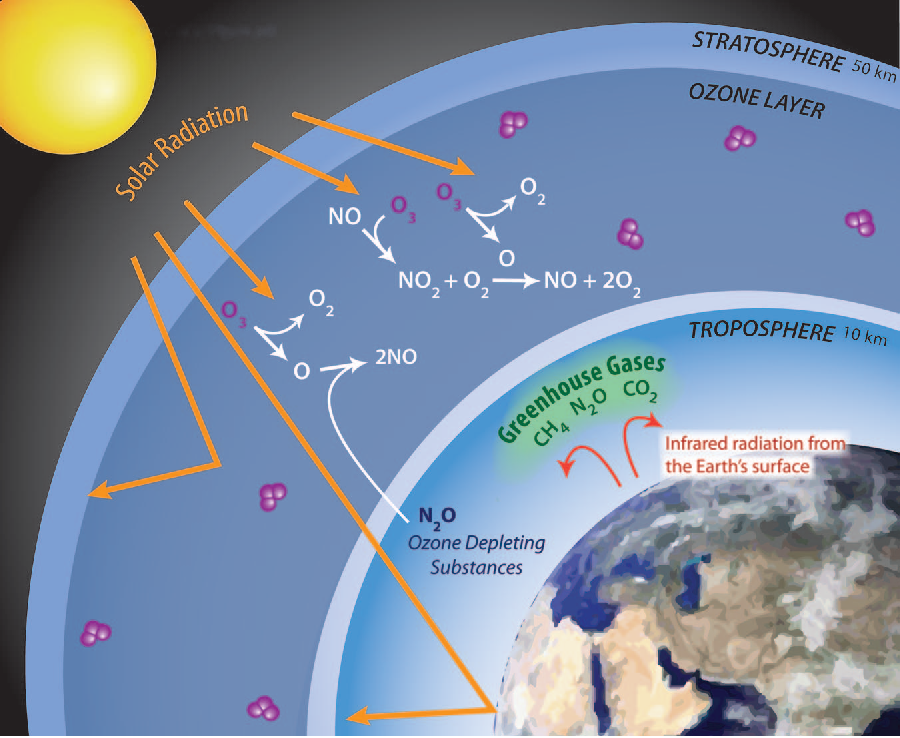
Nitrous Oxide (N2O) is a major contributor to anthropogenic climate change.1 It is a known potent greenhouse gas and ozone depleter which is used within the healthcare system as an analgesic and sedative agent.2 Clinical use is mainly via Anaesthetists in the operating theatre and on the labour ward for pain relief for labouring mothers.
The aim of the Kn2oW Nitrous Campaign is to increase awareness around the detrimental environmental impacts of Nitrous Oxide and to help provide guidance on reducing health care emissions of this greenhouse gas. Click on the links in the above drop down menu for more information.
Environmental Impact of Nitrous Oxide
Nitrous Oxide (N2O) is a greenhouse gas with a 100 year Global Warming Potential 273 times that of carbon dioxide.1 This is primarily due to a long atmospheric lifetime. N2O lingers in the atmosphere for 110 years allowing it to move up into the stratosphere where it has ozone depleting effects.3 Therefore N2O used today for a paediatric induction will likely still be in the atmosphere for the entirety of that childs lifetime.
A recent Intergovernmental Panel on Climate Change report states that net zero CO2 emissions are required by the early 2050’s to limit global warming to a somewhat manageable 1.5 degrees.1 This means that reducing our carbon emissions has never been more important. The healthcare sector in Australia accounts for 7% of the total national carbon footprint.4 N2O is estimated to be roughly 2-3% of the National Health Service (NHS) emissions in the UK.5,6 Therefore assuming similar N2O use in Australia it is a significant single agent contributor to climate change. As one of the primary users of N2O in the health care setting Anaesthetists are in a prime position to drive change in this area.

Figure 1: N2O environmental impact. Image reproduced from Ishizawa Y. General anaesthetic gases and the global environment. Anaesthesia and analgesia. 2011.
Evidence for Clinical Nitrous Oxide Use.
Nitrous oxide is one of the earliest anaesthetic agents to be discovered with its first clinical use by dentists in 1844.2 It provides both sedation and analgesia and has a rapid onset and offset which has led to its ongoing use into the 21st century. However, the development of newer anaesthetic agents and better understanding of climate science has an increasing number of Anaesthetists questioning the role of N2O in modern anaesthesia.
In Western countries use of nitrous oxide in anaesthesia is declining.7 The discovery of new anaesthetic drugs with rapid onset and offset pharmacokinetics and fast acting opioids has removed the clinical need for Nitrous Oxide. Audit of the Sir Charles Gairdner Hospital consultant body found minimal clinical use of Nitrous Oxide at this adult only hospital. Common situations in which it is still used within anaesthesia include as part of a paediatric gas induction and in GA caesarean sections to limit uterine atony from sevoflurane. As Total Intravenous Anaesthesia (TIVA) becomes a more common anaesthetic approach in these two patient groups the clinical use of Nitrous oxide will be further diminished.
The major clinical use of nitrous oxide is not in theatres but on the labour and birth suite. Nitrous oxide is used in labour as an analgesic despite having poor evidence for its efficacy.8 It has been shown to provide small improvements in pain scores when compared with placebo at the expense of higher rates of nausea, vomiting and dizziness.8 It has been shown to be less efficacious then epidural and Remifentnail PCA. Reducing emissions in this area is difficult but several strategies have been proposed. Antenatal education of mothers to help them make informed decisions about labour analgesia and earlier epidural or PCA may both reduce nitrous oxide use. Nitrous oxide destruction systems have been introduced in Sweden and have helped them reduce their labour nitrous oxide use by 50%.8 Limiting the clinical use and wastage of nitrous oxide along with safe destruction of this gas provide means by which emissions of Nitrous Oxide can be reduced.
Contact List
Dr Elliot Smith, Provisional Fellow SCGH Contact us
Dr Chris Mitchell, Consultant Anaesthetist SCGH Contact us
References
1. Climate change 2021: The physical science basis. [internet]. New York (USA): Intergovernmental Panel on Climate Change; 2021 [cited 2023 Feb 14]. Available from: https://www.ipcc.ch/report/ar6/wg1/
2. Buhre et al. European Society of Anaesthesiology Task Force on Nitrous Oxide: a narrative review of its role in clinical practice. BJA. 2019; 122(5): 587-604.
3. Campbell M, Pierce T. Atmospheric science, anaesthesia and the environment. BJA Education. 2015; 15(4): 173-179.
4. Malik et al. The carbon footprint of Australia health care. Lancet Planet Health. 2018; 2: 27-35.
5. Baddley J. Is green the new blue? 2019 [cited 11 July 2022]. Available from: https://www.youtube.com/watch?v1⁄4x5yl7nZsApQ.
6. Faculty of Public Health Special Interest Group: Sustainable Development. The NHS carbon footprint [internet] 2018 [cited 11 July 2022]. Available from: https://www.fph.org.uk/media/3126/k9-fph-sig-nhs-carbon-footprint-final.pdf
7. Brown S, Sneyd J. Nitrous oxide in modern anaesthetic practice. BJA Education. 2016; 16(3): 87-91.
8. Riley et al. Australasian Anaesthesia. ANZCA. 2021 [cited 10 Dec 2022]. Available from : https://www.anzca.edu.au/resources/college-publications/australasian-anaesthesia-(the-blue-book)/blue-book-2021.pdf
